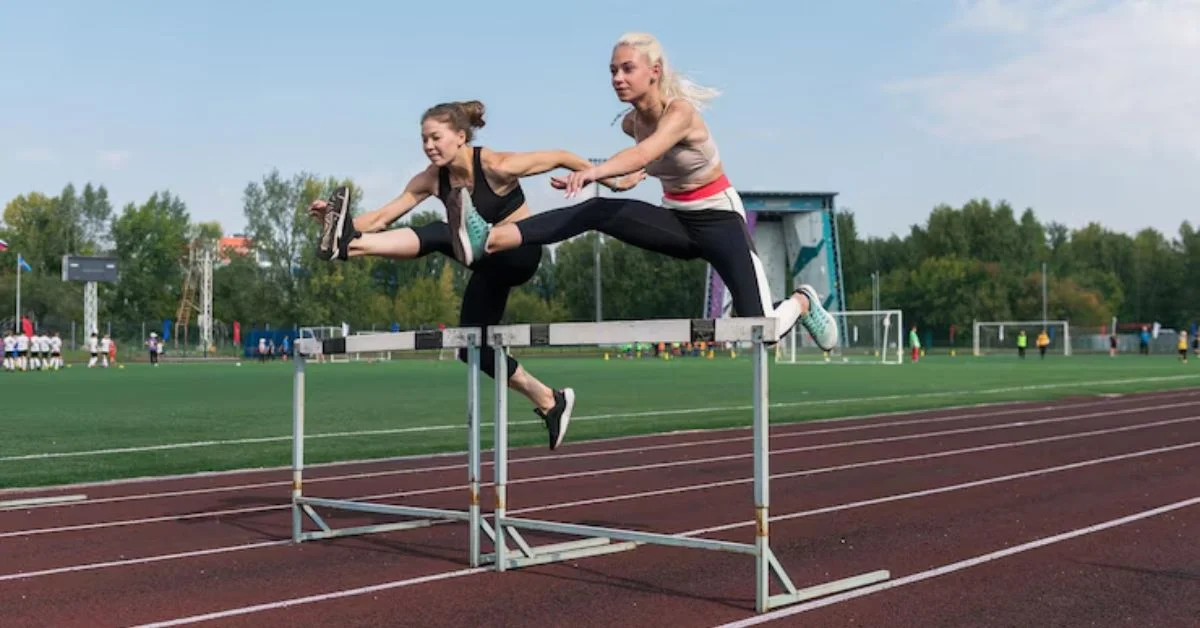Hurdle Techniques- Finding the right mix of biomechanics, patience, and inspiration to train athletes to instruct others in hurdle methods is no easy task. An efficient method of instruction may provide remarkable results, whether you’re training novice hurdlers or honing the skills of an experienced competitor.
In this guide, you’ll learn a proven step-by-step method to develop world-class hurdling skills.
Understanding Hurdling Basics
Before diving into drills and workouts, coaches must understand what makes hurdling unique:
- Sprint mechanics: Maintain maximum velocity between hurdles.
- Technical precision: Clear hurdles efficiently without breaking stride.
- Rhythm and timing: Essential for maintaining race momentum.
“Teaching hurdles is like choreographing a perfect dance – one misstep can break the flow.”
Key Phases of Hurdling
Teaching hurdling effectively involves breaking down the race into manageable phases:
- Start and Acceleration Phase
- Approach to First Hurdle
- Take-off and Clearance
- Landing and Recovery
- Sprint Between Hurdles
- Finish Strong
Each phase demands specific coaching points to fine-tune an athlete’s performance.
Hurdling Phases Overview (HTML Table)
| Phase | Coaching Focus |
|---|---|
| Start | Explosive power, quick reaction |
| Approach | Controlled, aggressive strides |
| Take-off | Optimal knee drive, minimal air time |
| Clearance | Efficient hip movement, low trail leg |
| Landing | Quick recovery, resume sprint mechanics |
| Finish | Max sprint effort through the line |
Essential Equipment for Hurdle Training
Proper equipment is key to a successful training session:
- Adjustable training hurdles
- Mini hurdles for drills
- Cones for stride pattern drills
- Stopwatches for timing
- Sprint sleds or resistance bands
Bonus Tip:
Always adjust hurdle height during early training to build athlete confidence before moving to regulation heights.

Step-by-Step Process: How to Teach Hurdle Techniques
Here’s a proven framework:
1. Teach Basic Sprinting Form
Before adding hurdles, ensure your athletes master sprint mechanics: knee drive, arm swing, and foot strike.
2. Introduce Hurdle Walkovers
Use low-height hurdles to focus on leading leg, trail leg, and body posture.
3. Break Down Take-Off Mechanics
Teach:
- Leaning slightly forward
- Driving the lead knee up and over
- Short ground contact time
4. Focus on Clearance
Important points:
- Keep chest down over the hurdle
- Aggressive arm action
- Minimal vertical lift
5. Train Landing and Transition: Hurdle Techniques
Athletes should “snap down” the trail leg quickly and get back into sprinting mode.
6. Integrate Full Hurdle Drills
Start with 2-3 hurdles, focusing on maintaining rhythm.
7. Build Race Simulation
Progressively add hurdles until full race simulation is achieved.
“Repetition and gradual progression build muscle memory and race-day confidence.”
Top Drills to Develop Hurdling Skills
Use drills that isolate and strengthen key movements:
- Lead Leg Drills: Hurdle drill isolating just the lead leg over.
- Trail Leg Drills: Focus on quick, tight trail leg movement.
- Sprint-Over-Drills: Full sprint between mini hurdles.
- 3-Step Drills: Simulate race rhythm at shortened distances.
- Bounding Over Hurdles: Power development.
Important: Always drill technique at slower speeds before moving to full race pace.
Common Mistakes in Hurdle Training and How to Fix Them
1. Overstriding Between Hurdles
Solution: Work on maintaining consistent, aggressive strides.
2. Jumping Too High Over Hurdles
Solution: Emphasize forward lean and knee drive.
3. Slow Trail Leg Recovery
Solution: Trail leg snap drills and flexibility exercises.
4. Poor Rhythm and Timing
Solution: Consistent 3-step pattern drills and race pace practices.

Strength and Conditioning for Hurdlers
Strong, flexible athletes hurdle more effectively.
Key components:
- Explosive Power: Box jumps, plyometrics
- Core Stability: Planks, Russian twists
- Hip Flexibility: Dynamic stretches
- Sprint Endurance: Repeat sprints with short recovery
Expert Insight: “Hurdling is as much about strength and balance as it is about speed.”
Building Confidence and Race Strategy
Mental preparation is just as important as physical preparation.
Strategies:
- Positive Visualization: Mental rehearsals of perfect races.
- Routine Development: Consistent warm-up and pre-race rituals.
- Controlled Breathing: Helps manage pre-race anxiety.
- Focus on Process Goals: E.g., “lead leg drive” instead of “winning.”
Bonus Race Tips:
- Attack the first hurdle aggressively.
- Maintain focus between hurdles.
- Lean at the finish line to maximize placement.
Conclusion: Hurdle Techniques
A combination of technical expertise, patience, inspiration, and originality is needed to educate others how to teach hurdle skills. Your players may become competent hurdlers if you adopt a systematic approach, use appropriate workouts, and place equal emphasis on mental toughness.
FAQs: Hurdle Techniques
1. How do you teach beginners to hurdle?
Start by mastering sprint mechanics, then use low hurdle drills focusing on lead and trail leg coordination.
2. What is the most important skill in hurdling?
Maintaining rhythm and minimizing time over the hurdle are crucial for success.
3. At what age should athletes start hurdle training?
Light hurdle drills can begin around ages 10-12 with proper supervision and progressive load.
4. How many steps between hurdles for high school athletes?
Typically, three steps are taken between each hurdle in sprint hurdle events.
5. What is the best way to prevent hurdle injuries?
Focus on proper warm-up, flexibility, strength training, and gradual skill progression.
For more information, click here.









